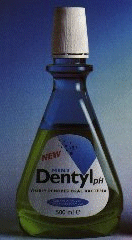
Get our Bad Breath Research Newsletter!


Making your own mouthwash
Some people like baking their own bread, preparing their own noodles, building their own
roofs, and so on. Such people are likely to want to know how to make their own mouthwash.
I have included here a few recipes.
 The basic
commercial mouthwash may contain up to about 2% of flavor (usually essential oils, mint is
what most people have in mind when they think of breath freshening - mind you, clove oil
is a more potent choice), up to 2% of a surfactant, to solubilize the flavor and to
provide foaming (which is not particularly helpful, but gives people the feeling that the
mouthwash is working), up to 2% humectant and/or thickener (add "body" to
rinse), alcohol (up to about 25%, it adds bite and freshness, enhances flavor, and may
have some antibacterial effect), and active ingredients. Ingredients which are reported to
have an effect in controlling odor include zinc chloride (usually around 0.2%), quaternary
ammonium compounds (for example, cetylpyridinium chloride up to 0.05%) and certain
combinations of essential oils. The most effective antibacterial agent present in
mouthwashes is probably chlorhexidine, which requires a prescription in others (US, only
up to 0.12%), but can be sold to anyone in Israel (up to 0.2%). Chlorhexidine is
problematic, causing pain and ulcerations in some users, heavy toothstaining and temporary
loss of taste. Chlorhexidine containing mouthwashes are good for initial diagnosis and
therapy (up to two weeks), as well as for post surgery treatment, but are not advised for
every day use. Although some investigators have reported that sodium bicarbonate reduces
bad breath, my suspicion is that it is relatively ineffective.
The basic
commercial mouthwash may contain up to about 2% of flavor (usually essential oils, mint is
what most people have in mind when they think of breath freshening - mind you, clove oil
is a more potent choice), up to 2% of a surfactant, to solubilize the flavor and to
provide foaming (which is not particularly helpful, but gives people the feeling that the
mouthwash is working), up to 2% humectant and/or thickener (add "body" to
rinse), alcohol (up to about 25%, it adds bite and freshness, enhances flavor, and may
have some antibacterial effect), and active ingredients. Ingredients which are reported to
have an effect in controlling odor include zinc chloride (usually around 0.2%), quaternary
ammonium compounds (for example, cetylpyridinium chloride up to 0.05%) and certain
combinations of essential oils. The most effective antibacterial agent present in
mouthwashes is probably chlorhexidine, which requires a prescription in others (US, only
up to 0.12%), but can be sold to anyone in Israel (up to 0.2%). Chlorhexidine is
problematic, causing pain and ulcerations in some users, heavy toothstaining and temporary
loss of taste. Chlorhexidine containing mouthwashes are good for initial diagnosis and
therapy (up to two weeks), as well as for post surgery treatment, but are not advised for
every day use. Although some investigators have reported that sodium bicarbonate reduces
bad breath, my suspicion is that it is relatively ineffective.
